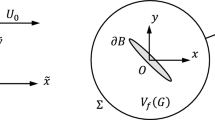Abstract
A new derivation of the Green-Naghdi (GN) equations for `sheet-like' flows is made by use of the principle of virtual work. Divergence-free virtual displacements are used to formulate the momentum equations weakly. This results in the elimination of the internal pressure from the GN equations. As is well-known in particle dynamics, the principle of virtual work can be integrated to obtain Hamilton's principle. These integrations can be performed in a straightforward manner when the Lagrangian description of fluid motion is adopted. When Hamilton's principle is written in an Eulerian reference frame, terms must be added to the Lagrangian to impose the Lin constraint to account for the difference between the Lagrangian and Eulerian variables (Lin). If, however, the Lin constraint is omitted, the scope of Hamilton's principle is confined to irrotational flows (Bretherton). This restricted Hamilton's principle is used to derive the new GN equations for irrotational flows with the same kinematic approximation as in the original derivation of the GN equations. The resulting new hierarchy of governing equations for irrotational flows (referred to herein as the IGN equations) has a considerably simpler structure than the corresponding hierarchy of the original GN governing equations that were not limited to irrotational flows. Finally, it will be shown that the conservation of both the in-sheet and cross-sheet circulation is satisfied more strongly by the IGN equations than by the original GN equations.
Similar content being viewed by others
References
J.S. Russell, 1837 Report of the Committee on Waves. Rep. of the 7th. Meet. of the Brit. Assn. Adv. Sci., Liverpool, John Murray, London, (1838) 417–496, 5 plates.
J. Boussinesq, Theorie de l'Intumescence liquide appele onde solitaire ou de translation. Comptes Rendus Acad. Sci. Paris 72 (1871) 755–759.
D.J. Korteweg and G. de Vries, On the change of form of long waves advancing in a rectangular canal and on a new type of long stationary waves. Phil. Mag. 39 (1895) 422–443.
J.C. Luke, A variational principle for a fluid with a free surface. J. Fluid Mech.27 (1967) 395–397.
G.B. Whitham, Variational methods and applications to water waves. Proc. R. Soc. London A 299 (1967) 6–25.
P.M. Naghdi, The Theory of Shells and Plates. In: C. Truesdell (ed.), S. Flugge's Handbuch der Physik, VIa/2. Berlin: Springer (1972) 425–640.
A.E. Green and P.M. Naghdi, Directed fluid sheets. Proc. R. Soc. London A 347 (1976) 447–473.
A.E. Green and P.M. Naghdi, A direct theory of viscous flow in channels. Arch. Rat. Mech. Anal. 86 (1984) 39–64.
R.C. Ertekin, Soliton Generation by Moving Disturbances in Shallow Water: Theory, Computation and Experiment. Ph. D. Dissertation, University of California at Berkeley (1984) vC352 pp.
A.E. Green and P.M. Naghdi, A derivation of equations for wave propagation in water of variable depth. J. Fluid Mech. 78(1976) 237–246.
J.J. Shields, A Direct Theory for Waves Approaching a Beach. Ph.D. Dissertation, University of California at Berkeley (1986) iiiC137 pp.
J.J. Shields and W.C. Webster, On direct methods in water-wave theory. J. Fluid Mech. 197 (1988) 171–199.
L.V. Kantorovich and V. I. Krylov, Approximate Methods of Higher Analysis. Groningen,The Netherlands: Noordhoff. (1964) 681 pp.
V.G. Levich and V.S. Krylov, Surface-tension driven phenomena. Ann. Rev. of FluidMech. 1 (1969) 293–316.
J.W. Kim and K.J. Bai, A note on Hamilton's principle for a free-surface flow problem. J. Soc. Naval Arch. Korea (In Korean) 27 (1990), 195–230.
K.J. Bai and J.W. Kim, A finite-element method for free-surface flow problems. J. Theoretical and App. Mech. 1 (1995) 1–27.
A.E. Green and P.M. Naghdi, Water waves in a nonhomogeneous incompressible fluid. J. App. Mech. 44 (1977) 523–528.
J.W. Miles and R. Salmon, Weakly dispersive, nonlinear gravity waves. J. Fluid Mech. 157 (1985) 519–531.
J.J. Shields and W.C. Webster, Conservation of mechanical energy and circulation in the theory of inviscid fluid sheets. J. Eng. Math. 23 (1989) 1–15.
R.C. Ertekin, W.C. Webster and J.V. Wehausen, Waves caused by a moving disturbance in a shallow channel of finite width. J. Fluid Mech. 169 (1986) 272–292.
J.W. Herivel, The derivation of the equations of motion of an ideal fluid by Hamilton's principle. Proc. Camb. Phil. Soc. 51 (1955) 344–349.
J. Serrin, Mathematical principles of classical fluid mechanics. In: S. Flüsse (ed.), Handbuch der Physik, VIII/1. Berlin: Springer (1959) pp. 125–263.
C.C. Lin, Hydrodynamics of liquid helium II. In: G. Careri (ed.), Proc. Intl School of Physics 'Enrico Fermi', Course XXI. Liquid Helium. New York: Academic Press (1963) 93–146.
R.L. Seliger and G.B. Whitham, Variational principles in continuum mechanics. Proc. R. Soc. London. A 305 (1968) 1–25.
F.P. Bretherton, A note on Hamilton's principle for perfect fluids. J. Fluid Mech. 44 (1970), 19–31.
H. Goldstein, Classical Mechanics. Reading, Mass: Addison-Wesley (1980), 672 pp.
Author information
Authors and Affiliations
Rights and permissions
About this article
Cite this article
Kim, J., Bai, K., Ertekin, R. et al. A derivation of the Green-Naghdi equations for irrotational flows. Journal of Engineering Mathematics 40, 17–42 (2001). https://doi.org/10.1023/A:1017541206391
Issue Date:
DOI: https://doi.org/10.1023/A:1017541206391




